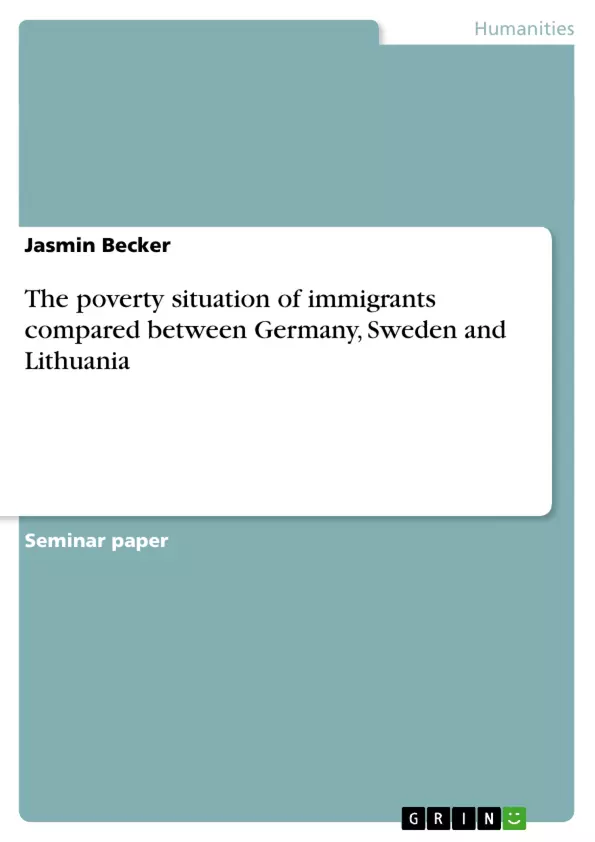On the following pages I’ll try to look at the situation of immigrants in the three
countries Germany, Sweden and Lithuania. I want to find out in which way poverty is
a problem for these people. Which are their chances on the labour market, their
educational chances, their health-situation, their living situation and their social
situation? Do they have a higher poverty risk than the established population? Which
specific problems do they have?
After describing the situation in each country I’ll try to make some comparisions and
find out the commonalities and differences.
Index
1. Introduction
2. The situation of immigrants in Germany
3. The situation of immigrants in Sweden
4. The situation of immigrants in Lithuania
5. Comparision
6. Bibliography
1. Introduction
On the following pages I’ll try to look at the situation of immigrants in the three countries Germany, Sweden and Lithuania. I want to find out in which way poverty is a problem for these people. Which are their chances on the labour market, their educational chances, their health-situation, their living situation and their social situation? Do they have a higher poverty risk than the established population? Which specific problems do they have?
After describing the situation in each country I’ll try to make some comparisions and find out the commonalities and differences.
2. The situation of immigrants in Germany
The recruitment of foreign labour, the admission of refugees and the return of ethnic German settlers from former Eastern bloc countries caused large numbers of migrants to Germany. At the end of 2003 7.8 million immigrants lived in Germany which makes nearly 9% of the whole population. The number of foreign population remained nearly constant between 1999 and 2003 while the number of asylum seekers went down. From these 7.3. million immigrants 25% are from EU states, 26% are from Turkey and 8% are from Serbia and Montenegra. 47% of the immigrants are women, so that there is an increasing number of women among the foreign population in Germany. An especially high number of foreign population lives in big cities like Frankfurt am Main, München and Stuttgart and in smaller industrial towns. The foreign population is younger than the german population: In 2002 47% of the immigrants are between 18 and 40 years old, but only 30% of the Germans. Only 10% of the immigrants were older than 60 years, but 26% of the Germans. In spring 2000 26.6% of all 15-year old pupils had a migration background which means that at least one parent was born in a foreign state[1].
Children of a foreign origin don’t have such a good school education as german children which makes the chances for participation for these children worse. So only 10.3% of the german children visit the “Hauptschule” (a school which ends after 9 years of school attention), but 21.1% of the children with a foreign citizenship. 13.6% of the german children visit the “Realschule” (a school which ends after 10 years of school), but 9.1% of the migrant children. 32.2% of the Germans attend the “Gymnasium” (a school which ends with the “Abitur” after 12 or 13 years = an exam which allows to go to university), but only 13.9% of the foreign children attend this type of school. There are also differences in the school leaving degree: While in 2002 only 8.2% of the german pupils left school without the leaving examination of the “Hauptschule”, 19.5 % of the children with foreign origin did so. 25.1% of the german pupils passed the school leaving exam which allows to go to university, but only 9.5% of the children with migration background.[2]
Migrants also have a lower participation on apprenticeships. One third of the foreign population aged between 20 and 29 has never learned a profession. The reasons for the lower participation of teenagers with a foreign origin on the apprenticeship market are that the number of apprenticeship places goes down, the school leaving degrees of the foreign teenagers are mostly worse than that of german teenagers, there are language defizits and the firms often have problems to address teenagers with a foreign origin.[3]
In 2003 20.4% of the immigrants were unemployed which is about twice as much as the rate among the whole population (11.7%). From all unemployed people in Germany 12.6% have a foreign origin and from all longtime-unemployed people it’s 33.4%. The reasons for the difficulties of the immigrants on the labour market are the language defizits and the mostly lower school and job qualification compared to the Germans. At the end of 2003 8.4% of the immigrants get “Sozialhilfe” (social security payment), but only 2.9% of the Germans and the unemployment of people with foreign origin is one of the main reasons for social security payment dependence.[4]
Table 1: percentage of households getting social security payment among all households of this kind[5]
Abbildung in dieser Leseprobe nicht enthalten
A good fact is, that there are no general problems with the living situation of immigrants which means that most foreign people in Germany are satisfied with their living situation.[6]
[...]
[1] Der 2. Armuts- und Reichtumsbericht der Bundesregierung, p. 158/159
[2] Der 2. Armuts- und Reichtumsbericht der Bundesregierung, p.159/160
[3] Der 2. Armuts- und Reichtumsbericht der Bundesregierung, p.160/161
[4] Der 2. Armuts- und Reichtumsbericht der Bundesregierung, p.161/162
[5] after table in: Der 2. Armuts- und Reichtumsbericht der Bundesregierung, p.163
[6] Der 2. Armuts- und Reichtumsbericht der Bundesregierung, p.164
- Arbeit zitieren
- Jasmin Becker (Autor:in), 2005, The poverty situation of immigrants compared between Germany, Sweden and Lithuania, München, GRIN Verlag, https://www.grin.com/document/39400



